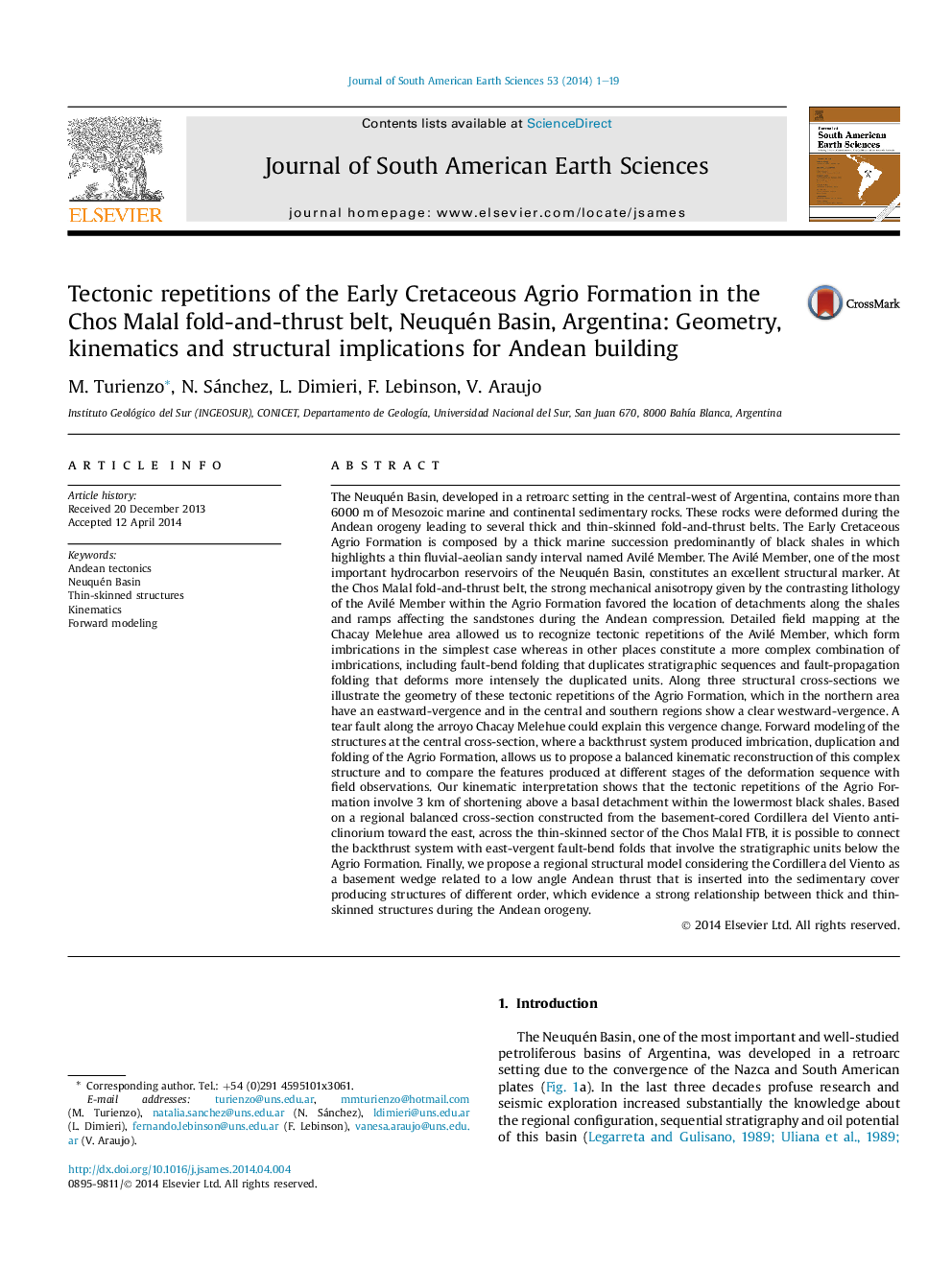| کد مقاله | کد نشریه | سال انتشار | مقاله انگلیسی | نسخه تمام متن |
|---|---|---|---|---|
| 4682279 | 1635156 | 2014 | 19 صفحه PDF | دانلود رایگان |

• Thrust systems repeat the Early Cretaceous Agrio Formation in the Neuquén Basin.
• The Chacay Melehue tear fault separates two domains with opposite vergences.
• A Kinematic model explains the sequential evolution of a complex backthrust system.
• Basement wedges originate thin-skinned structures of different order in cover rocks.
The Neuquén Basin, developed in a retroarc setting in the central-west of Argentina, contains more than 6000 m of Mesozoic marine and continental sedimentary rocks. These rocks were deformed during the Andean orogeny leading to several thick and thin-skinned fold-and-thrust belts. The Early Cretaceous Agrio Formation is composed by a thick marine succession predominantly of black shales in which highlights a thin fluvial-aeolian sandy interval named Avilé Member. The Avilé Member, one of the most important hydrocarbon reservoirs of the Neuquén Basin, constitutes an excellent structural marker. At the Chos Malal fold-and-thrust belt, the strong mechanical anisotropy given by the contrasting lithology of the Avilé Member within the Agrio Formation favored the location of detachments along the shales and ramps affecting the sandstones during the Andean compression. Detailed field mapping at the Chacay Melehue area allowed us to recognize tectonic repetitions of the Avilé Member, which form imbrications in the simplest case whereas in other places constitute a more complex combination of imbrications, including fault-bend folding that duplicates stratigraphic sequences and fault-propagation folding that deforms more intensely the duplicated units. Along three structural cross-sections we illustrate the geometry of these tectonic repetitions of the Agrio Formation, which in the northern area have an eastward-vergence and in the central and southern regions show a clear westward-vergence. A tear fault along the arroyo Chacay Melehue could explain this vergence change. Forward modeling of the structures at the central cross-section, where a backthrust system produced imbrication, duplication and folding of the Agrio Formation, allows us to propose a balanced kinematic reconstruction of this complex structure and to compare the features produced at different stages of the deformation sequence with field observations. Our kinematic interpretation shows that the tectonic repetitions of the Agrio Formation involve 3 km of shortening above a basal detachment within the lowermost black shales. Based on a regional balanced cross-section constructed from the basement-cored Cordillera del Viento anticlinorium toward the east, across the thin-skinned sector of the Chos Malal FTB, it is possible to connect the backthrust system with east-vergent fault-bend folds that involve the stratigraphic units below the Agrio Formation. Finally, we propose a regional structural model considering the Cordillera del Viento as a basement wedge related to a low angle Andean thrust that is inserted into the sedimentary cover producing structures of different order, which evidence a strong relationship between thick and thin-skinned structures during the Andean orogeny.
Figure optionsDownload as PowerPoint slide
Journal: Journal of South American Earth Sciences - Volume 53, August 2014, Pages 1–19